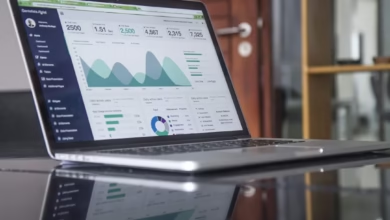Investor Reports Unveiled: Essential Insights and Trends for Stakeholders and Investors

In today's fast-paced financial landscape, investor reports play a crucial role in informing stakeholders and investors about the health and trajectory of businesses. These reports, ranging from annual reports to specialized market research and sustainability reports, provide essential insights that facilitate informed decision-making. Understanding the nuances of these documents can empower investors to navigate the complexities of the market more effectively. This article delves into the world of investor reports, offering a comprehensive guide to the various types of financial reports and market insights available. We will explore the key components of effective business performance reports, including how they capture essential data on sales, marketing, and risk assessments. Additionally, we will examine the latest trends in report analysis, focusing on how stakeholders leverage economic and industry reports to make strategic decisions. Whether you are a seasoned investor or new to the finance world, this guide will equip you with the knowledge needed to interpret and utilize investor reports to your advantage.
- 1. Understanding Investor Reports: A Comprehensive Guide to Financial and Market Insights
- 2. Key Components of Effective Business Performance Reports: From Annual Reports to Sustainability Reports
- 3. Trends in Report Analysis: How Stakeholders Use Economic and Industry Reports for Informed Decision-Making
1. Understanding Investor Reports: A Comprehensive Guide to Financial and Market Insights
Understanding investor reports is crucial for stakeholders and investors who seek to make informed decisions. These reports serve as comprehensive documents that compile various financial and market insights, offering a clear picture of a company's performance and prospects.
Investor reports typically encompass several types of documents, including annual reports, financial reports, and sustainability reports. Annual reports provide a complete overview of a company's activities over the past year, including financial results, strategic objectives, and future outlook. Financial reports, on the other hand, focus specifically on monetary performance, detailing revenues, expenses, and overall profitability.
Market research plays a critical role in shaping investor reports by analyzing market trends, consumer behavior, and economic conditions. This research is vital for understanding how external factors influence business performance. Economic reports can shed light on broader economic indicators that may affect investment decisions, such as inflation rates, employment statistics, and GDP growth.
Additionally, business performance reports offer insights into key performance indicators (KPIs) that measure the success of various departments, including sales, marketing, and customer service. Sales reports provide detailed data on revenue generation, while marketing reports analyze the effectiveness of marketing strategies and campaigns. Industry reports and competitor analysis further enhance the understanding of a company's position within its sector, identifying strengths and weaknesses relative to competitors.
Project reports and progress reports are essential for tracking the development of ongoing initiatives and investments. These documents help stakeholders assess whether projects are meeting predetermined goals and timelines. Risk assessment reports are equally important, as they evaluate potential risks associated with business operations and investments, allowing stakeholders to make informed decisions regarding their financial commitments.
In today's increasingly interconnected world, environmental and sustainability reports are becoming more prominent in investor communications. These reports demonstrate a company's commitment to sustainable practices and its impact on the environment. Healthcare reports, government reports, and energy reports may also be relevant, depending on the industry and specific interests of stakeholders.
To streamline the analysis of all these diverse reports, many organizations utilize report templates and software tools that facilitate the creation and evaluation of report trends. This enables stakeholders to quickly grasp the essential insights and make data-driven decisions that align with their investment strategies.
In summary, understanding investor reports requires a comprehensive approach that encompasses various types of reports. By analyzing financial reports, market research, and performance metrics, stakeholders can gain valuable insights into a company's health and prospects, ultimately guiding their investment decisions.
2. Key Components of Effective Business Performance Reports: From Annual Reports to Sustainability Reports
Effective business performance reports are crucial for stakeholders and investors to gain a clear understanding of a company's operations and overall health. These reports encompass a variety of formats, each serving specific purposes and audiences. Here are the key components that make up effective business performance reports, including annual reports and sustainability reports.
1. **Financial Overview**: At the heart of any business performance report is the financial analysis. Financial reports should provide a comprehensive view of the company's revenue, expenses, and profit margins. Key metrics such as earnings before interest and taxes (EBIT) and net income help stakeholders assess the company's financial health. Including trend analysis in financial reports can offer insights into historical performance and future projections.
2. **Market Research and Competitive Analysis**: Understanding the market landscape is essential for decision-making. Reports should incorporate market research findings that detail industry trends, customer preferences, and competitor analysis. This information allows stakeholders to make informed decisions regarding investments and strategic planning.
3. **Sustainability Metrics**: As sustainability becomes increasingly important, business performance reports should also include sustainability reports that outline a company's environmental impact and initiatives. These reports can include energy reports, waste management practices, and other environmental reports that demonstrate a commitment to corporate social responsibility.
4. **Sales and Marketing Insights**: Sales reports and marketing reports are critical for understanding the effectiveness of strategies employed by the company. These reports should highlight sales performance, marketing campaigns, customer feedback reports, and growth opportunities to provide a comprehensive view of market positioning.
5. **Risk Assessment**: Investors need to be aware of potential risks that could impact business performance. Risk assessment reports should identify internal and external risks, including economic reports that analyze market volatility and government reports that address regulatory changes. This information is vital for stakeholders to evaluate the risk-reward profile of their investments.
6. **Progress and Audit Reports**: Regular progress reports help keep stakeholders informed about ongoing projects and initiatives. Audit reports ensure transparency and compliance, giving investors confidence in the integrity of the company's financial statements and operational practices.
7. **Diverse Report Types**: A well-rounded business performance report will include various types of reports such as project reports, HR reports, IT reports, and supply chain reports. Each of these areas provides valuable insights into different aspects of the business, allowing stakeholders to analyze performance holistically.
8. **Report Templates and Trends**: Utilizing standardized report templates can enhance clarity and consistency across different types of reports. Staying abreast of report trends, such as the increasing use of visualization tools, can make report analysis more engaging and informative for investors.
In conclusion, effective business performance reports are multifaceted and should encompass a range of elements to provide stakeholders and investors with a comprehensive overview of a company's performance, risks, and opportunities. By focusing on these key components, organizations can create reports that not only meet regulatory requirements but also foster trust and transparency with their investors.
3. Trends in Report Analysis: How Stakeholders Use Economic and Industry Reports for Informed Decision-Making
In today's fast-paced business environment, stakeholders and investors rely increasingly on various types of reports to make informed decisions regarding their investments and business strategies. The trend in report analysis highlights how stakeholders are leveraging economic and industry reports to gain deeper insights into market dynamics and business performance.
Financial reports, including annual reports and audit reports, provide essential data regarding a company's profitability, liquidity, and overall financial health. Stakeholders analyze these documents to assess trends in revenue generation and cost management, enabling them to make decisions that align with their risk tolerance and investment goals.
Market research reports are another critical resource, offering insights into consumer behavior and industry trends. Investors can evaluate competitor analysis within these reports to understand market positioning and potential growth avenues. This analysis helps stakeholders identify lucrative investment opportunities while mitigating risks associated with market fluctuations.
Moreover, sustainability reports have gained prominence as investors increasingly consider environmental, social, and governance (ESG) factors in their decision-making. These reports provide transparency regarding a company's sustainability practices, allowing stakeholders to evaluate business performance not just in financial terms but also in terms of ethical impact and long-term viability.
As businesses continue to evolve, the use of diverse report formats such as project reports, sales reports, and progress reports has become essential. Stakeholders utilize these documents to track key performance indicators (KPIs) and assess the effectiveness of business strategies. For instance, IT reports and HR reports provide insights into operational efficiency and workforce dynamics, which are critical for strategic planning.
Overall, the trend towards comprehensive report analysis underscores the importance of utilizing varied report types—ranging from environmental reports to healthcare reports—in order to develop a holistic understanding of market conditions. By integrating data from multiple sources, stakeholders can make informed decisions that drive business success and optimize performance amidst changing economic landscapes.
In summary, the analysis of reports is not merely a routine task; it has evolved into a strategic practice that empowers stakeholders and investors to navigate the complexities of the market effectively. As new report trends emerge, the ability to synthesize information from diverse sources will continue to be a critical skill for those seeking to make data-driven investment decisions.
In conclusion, investor reports serve as critical tools that provide stakeholders and investors with invaluable insights into financial performance and market dynamics. By understanding the key components of effective business performance reports—including annual reports, sustainability reports, and risk assessment reports—investors can make more informed decisions that align with their financial goals. As trends in report analysis continue to evolve, the accessibility and comprehensiveness of economic reports, industry reports, and other specialized documentation are becoming increasingly important in shaping strategic initiatives.
With the rise of data-driven decision-making, utilizing various report templates and formats—such as sales reports, marketing reports, and competitor analysis—offers a clearer picture of business health and market positioning. Stakeholders who embrace these report trends are better equipped to navigate the complexities of the financial landscape, ensuring they remain agile and responsive to changing conditions. Ultimately, leveraging investor reports not only enhances transparency but also fosters a deeper connection between businesses and their investors, paving the way for sustainable growth and success in an ever-evolving market.
By staying attuned to the latest developments in report analysis and incorporating diverse report types, stakeholders can harness the power of information to drive strategic decision-making and optimize performance in their respective industries.





